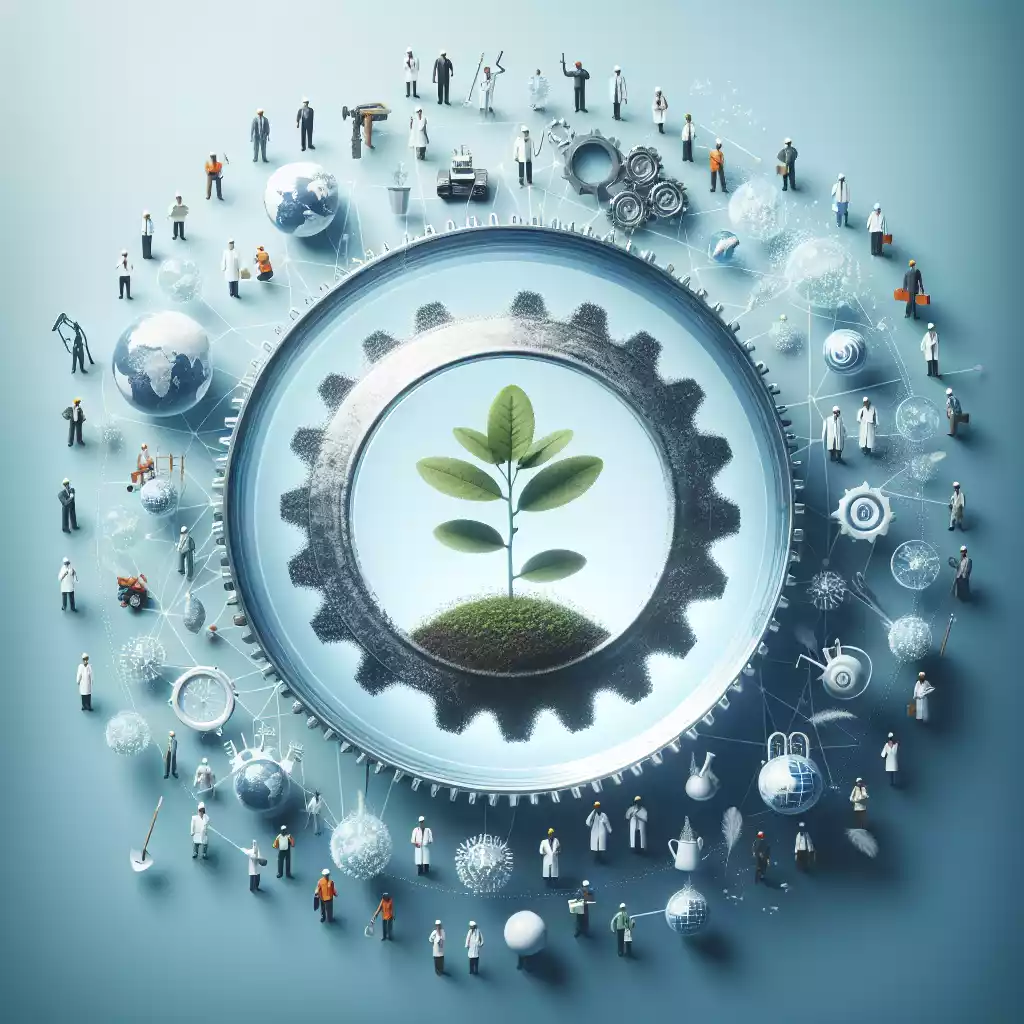Understanding Economic Growth
Economic growth is the increase in the production of goods and services in an economy over a period of time. It’s a vital indicator of a country’s economic health and is often measured by the rise in Gross Domestic Product (GDP). Historically, economic growth has been a key driver of improved living standards, technological advancements, and societal progress.
Definition and Importance of Economic Growth
Economic growth refers to the increase in a nation’s output of goods and services. This growth is crucial as it leads to higher income levels, better employment opportunities, and improved public services. For instance, during the Industrial Revolution, many countries experienced rapid economic growth, which significantly improved living standards and spurred technological innovation.
Historical Perspectives on Economic Growth
Industrial Revolution and Economic Expansion
The Industrial Revolution, which began in the late 18th century, marked a significant turning point in economic history. It introduced new manufacturing processes, leading to mass production and increased efficiency. This period saw unprecedented economic expansion, particularly in Western Europe and North America.
Post-War Economic Boom
After World War II, many countries experienced a period of rapid economic growth known as the post-war economic boom. This era was characterized by high levels of industrial production, technological innovation, and increased consumer spending. Countries like Japan and Germany, which were devastated by the war, rebuilt their economies and emerged as global economic powerhouses.
Key Drivers of Economic Growth
Several factors contribute to economic growth, including capital investment, labor force, and innovation. Understanding these drivers can help policymakers design effective strategies to stimulate growth.
Capital Investment
Capital investment involves spending on physical assets like infrastructure, machinery, and technology. These investments are essential for increasing productivity and fostering economic growth.
Infrastructure Development
Investing in infrastructure, such as roads, bridges, and ports, is crucial for economic growth. Good infrastructure facilitates trade, reduces transportation costs, and improves access to markets. For example, the construction of the Interstate Highway System in the United States during the 1950s and 1960s significantly boosted economic activity.
Technological Advancements
Technological advancements drive economic growth by improving efficiency and creating new industries. Innovations like the internet and mobile technology have revolutionized the way businesses operate and have opened up new opportunities for growth.
Labor Force
A skilled and productive labor force is another key driver of economic growth. Policies that enhance education and training can help build a more capable workforce.
Education and Skill Development
Investing in education and skill development is essential for economic growth. A well-educated workforce is more productive and can adapt to new technologies and industries. Countries like South Korea have invested heavily in education, leading to rapid economic growth and development.
Labor Market Policies
Effective labor market policies, such as minimum wage laws and unemployment benefits, can help create a more stable and productive workforce. These policies ensure that workers are fairly compensated and have access to job opportunities.
Innovation and Entrepreneurship
Innovation and entrepreneurship are critical for economic growth. They drive technological advancements, create new industries, and generate employment opportunities.
Research and Development
Investing in research and development (R&D) is crucial for fostering innovation. R&D activities lead to new products, processes, and technologies that can boost economic growth. Countries like the United States and Germany have strong R&D sectors, which have contributed to their economic success.
Start-up Ecosystem
A vibrant start-up ecosystem encourages entrepreneurship and innovation. Policies that support start-ups, such as access to funding and business incubators, can help create new businesses and drive economic growth.
Government Policies for Economic Growth
Government policies play a crucial role in shaping economic growth. Effective fiscal and monetary policies can stimulate economic activity and create a conducive environment for growth.
Fiscal Policies
Fiscal policies involve government spending and taxation. These policies can influence economic growth by affecting aggregate demand and investment.
Taxation Policies
Taxation policies can impact economic growth by influencing business investment and consumer spending. Lower taxes can stimulate investment and consumption, leading to higher economic growth. For example, the tax cuts implemented in the United States in the 1980s under President Reagan are credited with stimulating economic growth.
Government Spending
Government spending on infrastructure, education, and healthcare can boost economic growth by improving productivity and living standards. For instance, the New Deal programs in the United States during the 1930s involved significant government spending, which helped lift the country out of the Great Depression.
Monetary Policies
Monetary policies involve controlling the money supply and interest rates. These policies can influence economic growth by affecting borrowing costs and investment.
Interest Rates
Lower interest rates can stimulate economic growth by making borrowing cheaper for businesses and consumers. This can lead to increased investment and spending. For example, the low-interest-rate policies implemented by the Federal Reserve in response to the 2008 financial crisis helped stimulate economic recovery.
Inflation Control
Controlling inflation is essential for maintaining economic stability and growth. High inflation can erode purchasing power and create uncertainty, which can hinder economic growth. Central banks, like the European Central Bank, use monetary policy tools to keep inflation in check.
Trade and Economic Growth
International trade is a key driver of economic growth. Trade policies that promote exports and manage imports can help countries achieve sustainable growth.
International Trade Agreements
Trade agreements can open up new markets and create opportunities for economic growth. These agreements can reduce trade barriers and promote the free flow of goods and services.
Free Trade Agreements
Free trade agreements (FTAs) eliminate tariffs and other trade barriers between countries, promoting economic growth. For example, the North American Free Trade Agreement (NAFTA) has facilitated trade between the United States, Canada, and Mexico, boosting economic activity in the region.
Trade Barriers and Tariffs
While trade barriers and tariffs can protect domestic industries, they can also hinder economic growth by increasing costs and reducing competitiveness. Policies that reduce trade barriers can promote economic growth by encouraging competition and innovation.
Export and Import Strategies
Effective export and import strategies can help countries achieve economic growth by balancing trade and promoting domestic industries.
Export Promotion
Export promotion policies can help businesses access new markets and increase sales. These policies can include export subsidies, trade missions, and marketing support. For example, Japan’s export promotion policies in the post-war period helped the country become a leading exporter of electronics and automobiles.
Import Substitution
Import substitution policies aim to reduce dependence on imported goods by promoting domestic production. These policies can help build local industries and create jobs. For instance, Brazil’s import substitution policies in the mid-20th century helped develop its manufacturing sector.
Sustainable Economic Growth
Sustainable economic growth ensures that economic development meets the needs of the present without compromising the ability of future generations to meet their own needs. This involves balancing economic, environmental, and social considerations.
Environmental Considerations
Environmental sustainability is crucial for long-term economic growth. Policies that promote green technologies and renewable energy sources can help achieve sustainable growth.
Green Technologies
Investing in green technologies can drive economic growth while reducing environmental impact. Technologies like electric vehicles and energy-efficient buildings can create new industries and jobs. For example, the growth of the renewable energy sector in Germany has created thousands of jobs and reduced carbon emissions.
Renewable Energy Sources
Promoting renewable energy sources, such as solar and wind power, can help achieve sustainable economic growth. These energy sources are environmentally friendly and can reduce dependence on fossil fuels. Countries like Denmark have invested heavily in renewable energy, leading to economic growth and environmental benefits.
Social Equity
Social equity is essential for sustainable economic growth. Policies that promote income distribution and social safety nets can help create a more inclusive and stable economy.
Income Distribution
Fair income distribution ensures that the benefits of economic growth are shared by all members of society. Policies that promote progressive taxation and social welfare programs can help achieve this goal. For example, the Nordic countries have implemented policies that promote income equality, leading to high levels of social well-being and economic stability.
Social Safety Nets
Social safety nets, such as unemployment benefits and healthcare, can provide support to vulnerable populations and promote social stability. These programs can help reduce poverty and inequality, contributing to sustainable economic growth.
Challenges to Economic Growth
While economic growth is essential for development, it also faces several challenges. Addressing these challenges is crucial for achieving sustainable and inclusive growth.
Economic Inequality
Economic inequality can hinder economic growth by limiting access to opportunities and resources. Policies that promote inclusive growth can help address this challenge.
Wealth Gap
The wealth gap refers to the disparity in wealth distribution between different segments of society. Addressing the wealth gap requires policies that promote fair income distribution and access to opportunities. For example, progressive taxation and social welfare programs can help reduce the wealth gap.
Access to Opportunities
Ensuring access to opportunities, such as education and healthcare, is essential for reducing economic inequality. Policies that promote equal access to these opportunities can help create a more inclusive economy. For instance, providing scholarships and financial aid can help disadvantaged students access higher education.
Political Instability
Political instability can create uncertainty and hinder economic growth. Stable political environments are essential for attracting investment and promoting economic development.
Policy Uncertainty
Policy uncertainty can deter investment and hinder economic growth. Clear and consistent policies can create a conducive environment for economic activity. For example, countries with stable and transparent regulatory frameworks tend to attract more foreign investment.
Corruption
Corruption can undermine economic growth by creating inefficiencies and increasing costs. Policies that promote transparency and accountability can help address this challenge. For instance, anti-corruption measures and strong legal frameworks can reduce corruption and promote economic growth.
Case Studies of Successful Economic Growth
Examining case studies of successful economic growth can provide valuable insights into effective strategies and policies.
East Asian Tigers
The East Asian Tigers, including South Korea and Singapore, are examples of countries that have achieved rapid economic growth through effective policies and strategies.
South Korea
South Korea’s economic growth is often attributed to its focus on education, innovation, and export-oriented policies. The country invested heavily in education and technology, leading to the development of a highly skilled workforce and a competitive economy.
Singapore
Singapore’s economic success is due to its strategic location, business-friendly policies, and investment in infrastructure. The country has created a conducive environment for business and investment, attracting multinational corporations and fostering economic growth.
Emerging Economies
Emerging economies, such as India and Brazil, have also achieved significant economic growth through various strategies and policies.
India
India’s economic growth is driven by its large and young population, technological advancements, and economic reforms. The country has implemented policies to promote entrepreneurship, innovation, and foreign investment, leading to rapid economic development.
Brazil
Brazil’s economic growth is attributed to its abundant natural resources, agricultural sector, and industrialization. The country has implemented policies to promote export-oriented growth and attract foreign investment, leading to economic expansion.
Future Trends in Economic Growth
Understanding future trends in economic growth can help policymakers design effective strategies to promote sustainable development.
Digital Economy
The digital economy is transforming the way businesses operate and creating new opportunities for economic growth.
E-commerce
E-commerce has revolutionized retail and created new opportunities for businesses and consumers. The growth of online shopping platforms, such as Amazon and Alibaba, has driven economic growth and created new jobs.
Digital Services
Digital services, such as cloud computing and digital marketing, are driving economic growth by improving efficiency and creating new industries. Companies like Google and Microsoft have leveraged digital services to achieve significant growth.
Globalization and Economic Integration
Globalization and economic integration are shaping the future of economic growth by promoting trade and investment.
Regional Trade Blocs
Regional trade blocs, such as the European Union and ASEAN, promote economic integration and create opportunities for growth. These blocs facilitate trade and investment, leading to economic development.
Global Supply Chains
Global supply chains are driving economic growth by improving efficiency and reducing costs. Companies like Apple and Toyota have leveraged global supply chains to achieve significant growth.
FAQs
FAQ 1: What are the main factors that contribute to national economic growth?
Several factors contribute to national economic growth, including capital investment, labor force, innovation, and government policies. Capital investment in infrastructure and technology can boost productivity and economic activity. A skilled and productive labor force is essential for economic growth, and policies that enhance education and training can help build a capable workforce. Innovation and entrepreneurship drive technological advancements and create new industries, contributing to economic growth. Government policies, such as fiscal and monetary policies, play a crucial role in shaping economic growth by influencing investment and consumption.
FAQ 2: How do government policies impact economic growth?
Government policies impact economic growth through fiscal and monetary measures. Fiscal policies, such as taxation and government spending, influence aggregate demand and investment. Lower taxes can stimulate investment and consumption, leading to higher economic growth. Government spending on infrastructure, education, and healthcare can boost productivity and living standards. Monetary policies, such as controlling interest rates and inflation, influence borrowing costs and investment. Lower interest rates can stimulate economic growth by making borrowing cheaper for businesses and consumers. Controlling inflation is essential for maintaining economic stability and growth.
FAQ 3: What role does innovation play in economic growth?
Innovation plays a crucial role in economic growth by driving technological advancements and creating new industries. Investing in research and development (R&D) leads to new products, processes, and technologies that can boost economic growth. A vibrant start-up ecosystem encourages entrepreneurship and innovation, creating new businesses and generating employment opportunities. Countries with strong R&D sectors, such as the United States and Germany, have achieved significant economic growth through innovation. Policies that support innovation, such as access to funding and business incubators, can help create a conducive environment for economic growth.
FAQ 4: How can countries achieve sustainable economic growth?
Countries can achieve sustainable economic growth by balancing economic, environmental, and social considerations. Environmental sustainability is crucial for long-term economic growth, and policies that promote green technologies and renewable energy sources can help achieve sustainable growth. Social equity is essential for sustainable economic growth, and policies that promote income distribution and social safety nets can help create a more inclusive and stable economy. Addressing challenges such as economic inequality and political instability is also crucial for achieving sustainable and inclusive growth. Policies that promote fair income distribution, access to opportunities, and transparency can help achieve sustainable economic growth.
FAQ 5: What are the common challenges faced by countries in achieving economic growth?
Countries face several challenges in achieving economic growth, including economic inequality, political instability, and corruption. Economic inequality can hinder economic growth by limiting access to opportunities and resources. Policies that promote inclusive growth can help address this challenge. Political instability can create uncertainty and hinder economic growth. Stable political environments are essential for attracting investment and promoting economic development. Corruption can undermine economic growth by creating inefficiencies and increasing costs. Policies that promote transparency and accountability can help address this challenge. Addressing these challenges is crucial for achieving sustainable and inclusive economic growth.
Conclusion
In conclusion, national economic growth is a multifaceted concept influenced by various factors, including capital investment, labor force, innovation, and government policies. Understanding these drivers and addressing challenges such as economic inequality and political instability is crucial for achieving sustainable and inclusive growth. By examining historical perspectives, key drivers, government policies, trade strategies, and future trends, we can gain valuable insights into effective strategies for promoting economic growth. Through careful planning and implementation of policies that balance economic, environmental, and social considerations, countries can achieve sustainable economic growth and improve the well-being of their citizens.
—
Relevant Data Table:
| Key Drivers | Examples |
|---|---|
| Capital Investment | Infrastructure Development, Technological Advancements |
| Labor Force | Education and Skill Development, Labor Market Policies |
| Innovation and Entrepreneurship | Research and Development, Start-up Ecosystem |
| Government Policies | Examples |
|---|---|
| Fiscal Policies | Taxation Policies, Government Spending |
| Monetary Policies | Interest Rates, Inflation Control |
—
This article provides a comprehensive overview of the national economic growth strategy, covering various aspects such as key drivers, government policies, trade strategies, and future trends. By understanding these factors and addressing challenges, countries can achieve sustainable and inclusive economic growth.
Breaking Barriers: Strategies for Business & Economic Growth
Welcome to the AI Blogging World! No need to stick with old-school methods anymore. I use AI to help you, but it won’t leave any footprint behind. With over 7 years of experience in content writing and digital marketing, you’re in the right place. From my personal experience, I know what format and quality Google loves for your blog. You’ll get the best results using this AAA tool.






